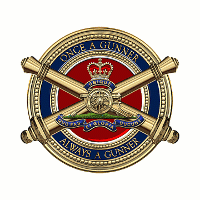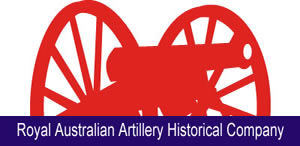I was interstate when Brigadier Ken Fullford passed away on 15 October and am aware that a tribute to this distinguished Gunner will be published in the next edition of 'Cannonball', the journal of the RAA Historical Company. However, I am conscious that this journal will not reach all those who knew him and the many others who knew of him. Since the Brigadier probably made his last Regimental public appearances at the retired Gunner officers' lunches in southeast Queensland, I am drafting this Vale to reach that wider audience to farewell this well known and highly respected tribal elder of, and someone who has made a significant contribution to the Royal Regiment of Australian Artillery.
This tribute is written using the sources of the Central Army Records Office, Matross' article in the June 2004 'Cannonball', Major General Gordon Fitzgerald AO (Retd)'s Memories of Ken at the Tweed Heads Crematorium Chapel on 19 October 2006 and information provided by son Richard Fullford (Junior).
In 1934, as a 16 year old emerging from the Great Depression, Richard Kennedy Fullford gave up his spare time when not working with the Commercial Banking Company of Sydney to become a senior cadet with the 14th Heavy Battery of the 1st Heavy Brigade, Australian Garrison Artillery. Though country service in northern New South Wales took him away from the coast guns for a couple of years, he rejoined his former battery which was now part of 5th Heavy Brigade on return to Sydney in 1938. Study was rewarded by promotion to bombardier and then lance sergeant. On the outbreak of war in 1939, General Fitzgerald tells of how Lance Sergeant Fullford applied to enlist in both the Navy and the Army. The mobilisation of his unit locked him into the Army.
Ken began serving on full time duty on 2 September 1939 and was appointed a lieutenant (on probation) in May 1940 at Breakwater (6th Battery), Port Kembla. His first command appointment came in March 1942 when he became the battery commander of Illowra Battery, Port Kembla as a temporary captain. Matross describes Captain Fullford's delight at loading and laying his guns on a suspicious radar plot one night. When the fortress commander ordered searchlights switched on, the 'blip' on the radar screen disappeared. Ken firmly believed that this saved the Port Kembla steelworks from being shelled.
Promotion to major in November 1942 was followed by staff appointments with the RAA (Militia) Lines of Communication and then command of 'O' Heavy Battery (155-mm M1917 A1 and M1918 ordnance). He took this battery to Queensland for training before deploying with it to Port Moresby in August 1943 and then serving at Buna before returning to Australia in July 1944. He relinquished command when the unit was disbanded a year later.
Seconded for special duties, Major Fullford was then appointed a staff officer with the British Borneo Civil Affairs Unit and later attached to agriculture and lands survey with the Military Administration in British Borneo. Ken was demobilised in July 1946 and placed on the Reserve of Officers RAA.
Unsettled in civvy street, Ken was accepted into the Interim Army in November 1948 as a major. He qualified at the Royal Military College Wing as a Staff Corps officer and was attached to 1st Coastal Artillery Battery. For two months in 1949, he was detached for special duties in Eastern Command assisting Lieutenant Colonel Ted Serong with training. (Ted Serong later led the Australian Army Training Team into Vietnam.) Ken attended the 1950 Staff College Course and then gained an operations special duties and training staff posting at Headquarters Eastern Command. An appointment in the Directorate of Military Training at Army Headquarters followed for 18 months before he was selected to attend a Long Gunnery Staff Course at Larkhill, UK in 1954. Graduating with the distinction of an A pass and with experience gained at HQRA 1st British Corps in Germany, Major Ken returned to Australia as the second-in-command of the School of Artillery.
Then began what General Fitzgerald describes as 'Ken's three plum command postings' - 1st Field Regiment 1960-61, School of Artillery 1962-64 and then, on promotion to colonel, Commander Northern Territory Command 1965-66. Sadly, 1960 saw the demise of his beloved coastal artillery and no one fought harder than he and Lieutenant Colonel Bill Ford to retain the 9.2-inch battery at North Head as an artillery historical site. This, however, was not to be. The early 60s were tumultuous times for the Army as the Regular force expanded after National Service ceased, it reorganised into the Pentropic Division and there were lengthy, significant exercises including Icebreaker, Nutcracker and Sky High which trialled the new concept of a brigade force for operations in South East Asia. Not only did Ken and his unit play an integral part in these demanding exercises, but at the School of Artillery, he became enmeshed in doctrine being rewritten and course exercises replanned at an intense rate - all of which he took well within his stride. The euphoria of Gunner command postings ended in a jolt back to the real world of the NT when Indonesia's President Sukarno began flexing his revolutionary and military muscles just across the water. Matross describes Ken's influence on successful policy changes in the Territory as leaving the Command all the better for the new policies.
In November 1966, Colonel Fullford became the Director of Manning at Army Headquarters, an appointment which became the Director Personnel Planning in 1972 and from which he retired on 1 April 1973. These seven years were arguably the most hectic for the Australian Army since the Second World War and in Gordon Fitzgerald's words, 'Ken was up to his neck introducing the National Service force, manpower maintenance for the force in Vietnam, the withdrawal and absorption of manpower from Vietnam, the cessation of National Service and the change to the functional command system'. Ken was recognised for his sterling work in these areas by appointment as an officer of the Order of the British Empire (OBE) in 1970. Despite all these challenges trying to chain him to a desk, Colonel Fullford managed overseas visits to the US and British Armies and two trips to Vietnam. Whilst in Vietnam, he fired his last artillery rounds from John Bertram's 101st Field Battery's guns in an air observation mission using, as Matross describes it, 'a script of the new fire discipline jargon provided by the battery commander'.
Placed on the Retired List and granted the military title of brigadier, Ken Fullford never forgot his Gunner roots. He had been a foundation member of the RAA Association of NSW in 1948 and served three years as its president in the 1960s. Major Roy Harvey (Retd) coerced him into beginning an oral history of his coast gunner experience but, with typical enthusiasm for this theme and encouragement from his old friend, Major General John Whitelaw AO CBE (Retd), he authored the book 'We Stood and Waited' in 1994. Not satisfied with this single achievement, Ken then began his autobiography, 'Once a Gunner Always a Gunner' which was completed in 2003. (What a wonderful way to describe his dedication to and love of the Royal Regiment.) In retirement at Banora Point on the Gold Coast, Brigadier Fullford was always one of the first members of the retired Gunner officer fraternity in southeast Queensland and northern New South Wales to reply to the Colonel Commandant RAA's invitation to quarterly lunches at Victoria Barracks. On the appointed day, he would usually arrive in the company of his friend, Major General Fitzgerald and without any doubt, he was a very respected tribal elder. To be seated next to the brigadier was a guarantee of becoming involved in deep and meaningful discussions on matters of technical gunnery from which one would inevitably depart having enjoyed the company and better educated by the experience. During the last 12 months when he was too frail to travel up to Brisbane, Dallas said that 'his computer was his only interest' and I would keep in touch via an email of the RAA 'Parish Notices' that had been informed at each luncheon. Without hesitation, I could always guarantee a cheery 'thank you' in response and a deep appreciation for keeping him advised of topical Gunner matters. Our last exchange was on 16 September.
Ken married Dallas on 16 December 1950 and they were blessed with two sons, Richard now in Canberra and Andrew in Dallas, Texas, USA. On retirement from the military, Ken spent the next six years as the national secretary to the Scout Association. At 60 years of age, he retired a second time and moved with Dallas to Ocean Shores near Byron Bay in northern NSW. There, he became active in the Ocean Shores Country Club Committee rising to chairman, and in Lismore Legacy where he became president. In 1998 they moved to the Banora Point Retirement Village where, as enthusiastic as ever, he served on the Residents' Committee in a number of positions, including that of chairman for three years.
Brigadier Fullford passed away peacefully on 15 October 2006. In accordance with his last wishes, the coffin was adorned with his RAA ceremonial sword held in trust by each commanding officer of 1st Field Regiment RAA and a slouch hat. General Fitzgerald provided the military memories during the service at the Tweed Heads Crematorium Chapel and the RSL conducted a poppy tribute. No eulogy to Ken Fullford would be complete without mentioning his nickname, 'Hesh'. As his son, Richard explained during the family tributes at the service, the shape of Ken's prematurely bald pate was perfectly akin to the business end of a High Explosive Squash Head artillery round. Some military wag had observed this and christened him 'HESH'. The name stuck as a term of endearment for this much respected artilleryman. The brigadier was never addressed by his nickname, but 'Hesh Fullford' was his common name in any Gunner circle discussion. Dallas wrote to me, '. . . the whole service was excellent, I am sure Ken would have approved.'
Vale Brigadier Richard Kennedy Fullford OBE - coast gunner cadet, commanding officer, author and energetic tribal elder of the Royal Regiment of Australian Artillery. Ascending at 88 years of age undoubtedly to his next challenge on the Great Gun Park up above. The Regiment is richer for your 72 years of dedicated, loyal and professional service. |






